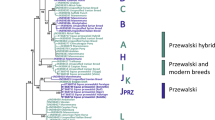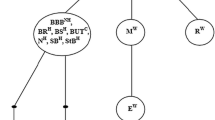Abstract
The evolution, taxonomy and conservation of the genus Equuswere investigated by examining the mitochondrial DNA sequences of thecontrol region and 12S rRNA gene. The phylogenetic analysis of thesesequences provides further evidence that the deepest node in thephylogeny of the extant species is a divergence between twolineages; one leading to the ancestor of modern horses (E.ferus, domestic and przewalskii) and the other to thezebra and ass ancestor, with the later speciation events of the zebrasand asses occurring either as one or more rapid radiations, or withextensive secondary contact after speciation. Examination of the geneticdiversity within species suggested that two of the E. hemionussubspecies (E. h. onager and E. h. kulan) onlyrecently diverged, and perhaps, are insufficiently different to beclassified as separate subspecies. The genetic divergence betweendomestic and wild forms of E. ferus (horse) and E.africanus (African ass) was no greater than expected within anequid species. In E. burchelli (plains zebra) there was anindication of mtDNA divergence between populations increasing withdistance. The implications of these results for equid conservation arediscussed and recommendations are made for conservation action.
Similar content being viewed by others
References
Azzaroli A (1990) The genus Equus in Europe. In: Nato Advanced Workshop: European Neogene Mammal Chronology (eds. Lindsay EH, Fahlbusch V, Mein P), pp. 339-356. Plenum Press, New York.
Azzaroli A (1992) Ascent and decline of monodactyl equids: a case for prehistoric overkill. Ann. Zool. Fennici., 28, 151-163.
Benirschke K, Malouf N, Low R, Heck H (1965) Chromosome complement differences between Equus caballus and Equus przewalskii, Poliakoff. Science, 148, 382.
Bennet DK (1980) Stripes do not a zebra make, Part 1: a cladistic analysis of Equus. Syst. Zool., 29, 272-287.
Bouman I, Bouman J (1994) The history of Przewalski' Horse. In: Przewalski' Horse: the History and Biology of an Endangered Species (eds. Boyd L, Houpt KA), pp. 5-38. State University of New York Press, Albany.
Britton-Davidian J, Catalan J, da Graça Ramalhinho M, Ganem G, Auffray J-C, Capela R, Biscoito M, Searle JB, da Luz Mathias M (2000) Rapid chromosomal evolution in island mice. Nature, 403, 158.
Clegg JB (1974) Horse hemoglobin polymorphism. Ann. N.Y. Acad. Sci., 241, 61-69.
Crandall KA, Bininda-Emonds ORP, Mace GM, Wayne RK (2000) Considering evolutionary processes in conservation biology. TREE, 15, 290-295.
Duncan P (1992) ed. Zebras, Asses and Horses: an Action Plan for the Conservation of Wild Equids. IUCN/SSC Equid specialist group, Gland, Switzerland.
Eisenmann V (1979) Caractè res évolutifs et phylogénie du genre Equus (Mammalia, Perissodactyla). C.R. Acad. Sc. Paris., 288, 497-500.
Eisenmann V (1992) Origins, dispersals, and migrations of Equus (Mammalia, Perissodactyla). Courier Forsch.-Inst. Senckenberg., 153, 161-170.
Eisenmann V, Shah N (1996) Some craniological observations on the Iranian, Transcaspian, Mongolian and Indian hemiones. In: EEP Yearbook 1995/96 (eds. Rietkerk F, Brouwer K, Smits S), pp. 396-399. EAZA Executive Office, Amsterdam.
Felsenstein J (1993) PHYLIP. Phylogeny Inference Package. Version 3.572c. University of Washington, Seattle, WA.
Forstén A (1988) Middle Pleistocene replacement of Stenoid horses by Caballoid horses-ecological implications. Palaeogeogr. Palaeoclimatol. Palaeoecol., 65, 23-33.
Forstén A (1992) Mitochondrial-DNA time-table and the evolution of Equus: comparison of molecular and paleontological evidence. Ann. Zool. Fennici., 28, 301-309.
George M, Ryder OA (1986) Mitochondrial DNA evolution in the genus Equus. Mol. Biol. Evol., 3, 535-546.
Girman DJ, Kat PW, Mills MG, Ginsberg JR, Borner M, Wilson V, Fanshawe JH, Fitzgibbon C, Lau LM, Wayne RK (1993) Molecular genetic and morphological analyses of the African wild dog (Lycaon pictus). J. Hered., 84, 450-459.
Groves CP, Mazák V (1967) On some taxonomic problems of Asiatic wild asses; with the description of a new subspecies (Perissodactyla; Equidae). Z. Saugetierkunde., 32, 321-355.
Groves CP (1995) On the nomenclature of domestic animals. Bulletin of Zoological Nomenclature., 52, 137-141.
Harris AH, Porter LS (1980) Late Pleistocene horses of Dry Cave, Eddy County, New Mexico. J. Mamm., 61, 46-65.
Hickson RE, Simon C, Cooper A, Spicer GS, Sullivan J, Penny D (1996) Conserved sequence motifs, alignment and secondary structure for the third domain of animal 12S rRNA. Mol. Biol. Evol., 13, 150-169.
Ishida N, Oyunsuren T, Mashima S, Mukoyama H, Saitou N (1995) Mitochondrial DNA sequences of various species of the genus Equus with special reference to the phylogenetic relationship between Przewalski' wild horse and domestic horse. J. Mol. Evol., 41, 180-188.
Kaminski M (1979) The biochemical evolution of the horse. Comp. Biochem. Physiol., 63B, 175-178.
Kingswood SC, Kumamoto AT, Charter SJ, Jones ML (1998) Cryptic chromosomal variation in suni Neotragus moschatus (Artiodactyla, Bovidae). Anim. Cons., 1, 95-100.
Klein RG, Cruz-Uribe K (1999) Craniometry of the genus Equus and the taxonomic affinities of the extinct South African quagga. S. Afr. J. Sci., 95, 81-86.
Kocher TD, Thomas WK, Meyer A, Edwards SV, Pääbo S, Villablanca FX, Wilson WC (1989) Dynamics of mitochondrial DNA evolution in animals: amplification and sequencing with conserved primers. Proc. Natl. Acad. Sci. USA., 86, 6196-6200.
Kumar S, Tamura K, Nei M (1993) MEGA: Molecular evolutionary genetic analysis. Version 1.01. The Pennsylvania State University, University Park, PA.
LaRue MD (1996) North American Regional Studbook of the African and Asiatic Wild Asses. Topeka Zoological Park, Topeka, Kansas.
Lowenstein JM, Ryder OA (1985) Immunological systematics of the extinct quagga (Equidae). Experientia., 41, 1192-1193.
MacFadden BJ, Hulbert RC (1988) Explosive speciation at the base of the adaptive radiation of Miocene grazing horses. Nature., 336, 466-468.
MacFadden BJ, Solounias N, Cerling TE (1999) Ancient diets, ecology, and extinction of 5-million-year-old horses from Florida. Science, 283, 824-827.
Matthee CA, Robinson TJ (1997) Mitochondrial DNA phylogeography and comparative cytogenetics of the springhare, Pedetes capensis (Mammalia: Rodentia). J. Mamm. Evol., 4, 53-73.
Matthee CA, Robinson TJ (1999) Mitochondrial DNA population structure of roan and sable antelope: implications for the translocation and conservation of the species. Mol. Ecol., 8, 227-238.
Mindell DP, Honeycutt RL (1990) Ribosomal RNA in vertebrates: evolution and phylogenetic applications. Annu. Rev. Ecol. Sys., 21, 541-566.
Mohr E (1959) Das Urwildpferd. A Ziemsen Verlag, Wittenberg, Lutherstadt.
Moritz C (1994) Defining ‘Evolutionarily Significant Units’ for conservation. Trends Ecol. Evol., 9, 373-375.
Oakenfull EA, Clegg JB (1998) Phylogenetic relationships within the genus Equus and the evolution of α and θ globin genes. J. Mol. Evol., 47, 772-783.
Oakenfull EA, Ryder OA (1998) Mitochondrial control region and 12S rRNA variation in Przewalski' horse (Equus przewalskii). Anim. Genet., 29, 456-459.
Pohle C. (1971) International Studbook of the Asiatic Wild Asses. Tierpark, Berlin.
Prothero DR, Schoch RM (1989) Origin and evolution of the Perissodactyla: summary and synthesis. In: The Evolution of Perissodactyls (eds. Prothero DR, Schoch RM), pp. 504-529. Clarendon Press, Oxford University Press, New York, Oxford.
Ryder OA (1978) Chromosomal polymorphism in Equus hemionus. Cytogenet. Cell Genet., 21, 177-183.
Ryder OA, Epel NC, Benirschke K (1978) Chromosome banding studies of the Equidae. Cytogenet. Cell Genet., 20, 323-350.
Ryder OA (1986) Species conservation and systematics: the dilemma of subspecies. TREE, 1, 9-10.
Ryder OA, Chemnick LG (1990) Chromosomal and molecular evolution in Asiatic wild asses. Genetica., 83, 67-72.
Ryder OA (1994) Genetic studies of Przewalski' Horses and their impact on conservation. In: Przewalski' Horses: the History and Biology of an Endangered Species (eds. Boyd L, Houpt KA), pp. 75-92. State University of New York Press, Albany.
Schreiber A, Fakler P, Zimmermann W (1996) Onager and kulan: efforts to resolve a 'subspecies problem'. In: EEP Yearbook 1995/96 (eds. Rietkerk F, Brouwer K, Smits S), pp. 400-402. EAZA Executive Office, Amsterdam.
Schneider CJ, Smith TB, Larison B, Moritz C (1999) A test of alternative models of diversification in tropical rainforests: ecological gradients vs. rainforest refugia. Proc. Natl. Acad. Sci., 96, 13869-13873.
Simpson GG (1953) The Major Features of Evolution. Columbia University Press, New York.
Smith TB, Wayne RK, Girman DJ, Bruford MW (1997) A role for ecotones in generating rainforest biodiversity. Science, 276, 1855-1857.
Springer MS, Douzery E (1996) Secondary structure and patterns of evolution among mammalian mitochondrial 12S rRNA molecules. J. Mol. Evol., 43, 357-373.
Strimmer K, vonHaeseler A (1996) Quartet puzzling: a quartet maximum likelihood method for reconstructing tree topologies. Mol. Biol. Evol., 13, 964-969.
Swofford DL (1999) PAUP*. Phylogenetic Analysis using Parsimony (*and other methods). Version 4.0. Sinauer Associates, Sunderland, Massachusetts.
Thompson JD, Higgins DG, Gibson TJ (1994) Clustal-W-Improving the sensitivity of progressive multiple sequence alignment through sequence weighting, position-specific gap penalties and weight matrix choice. Nucleic Acids Res., 22, 4673-4680.
van Dierendonck MC, de Vries MFW (1996) Ungulate reintroductions: experiences with the Takhi or Przewalski Horse (Equus ferus przewalskii) in Mongolia. Conserv. Biol., 10, 728-740.
Xu X, Arnason U (1994) The complete mitochondrial DNA sequence of the horse, Equus caballus: extensive heteroplasmy of the control region. Gene, 148, 357-362.
Xu X, Gullberg A, Arnason U (1996) The complete mitochondrial DNA (mtDNA) of the donkey and mtDNA comparisons among four closely related mammalian species-pairs. J. Mol. Evol., 43, 438-446.
Xu XF, Arnason U (1997) The complete mitochondrial DNA sequence of the white rhinoceros, Ceratotherium simum, and comparison with the mtDNA sequence of the Indian rhinoceros, Rhinoceros unicornis. Mol. Phylogenet. Evol., 7, 189-194.
Yang Z (1994a) Estimating the pattern of nucleotide substitution. J. Mol. Evol., 39, 105-111.
Yang Z (1994b) Maximum likelihood phylogenetic estimation from DNA sequences with variable rates over sites: approximate methods. J. Mol. Evol., 39, 306-314.
Author information
Authors and Affiliations
Corresponding author
Rights and permissions
About this article
Cite this article
Oakenfull, E.A., Lim, H.N. & Ryder, O.A. A survey of equid mitochondrial DNA: Implications for the evolution, genetic diversity and conservation of Equus. Conservation Genetics 1, 341–355 (2000). https://doi.org/10.1023/A:1011559200897
Issue Date:
DOI: https://doi.org/10.1023/A:1011559200897




